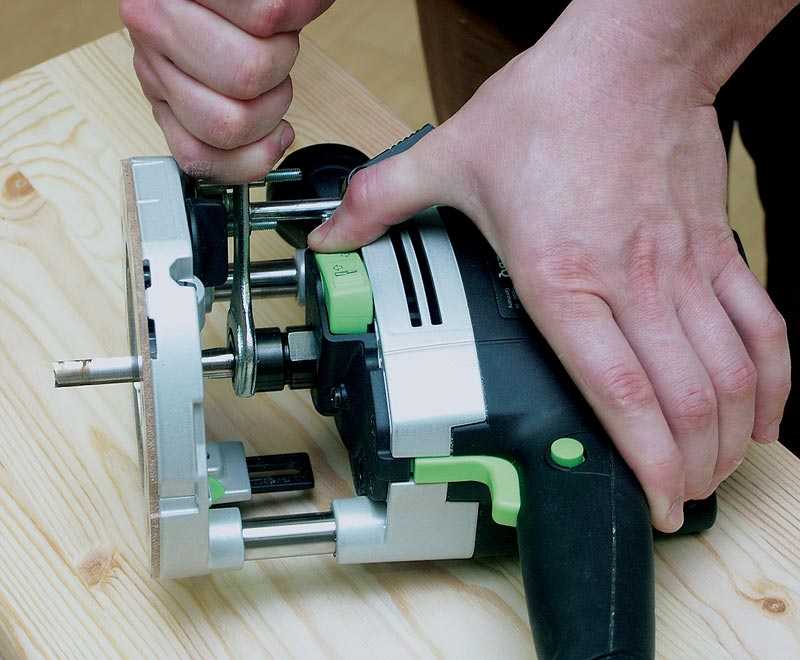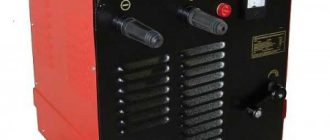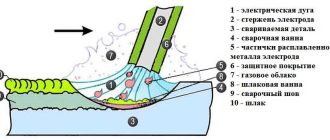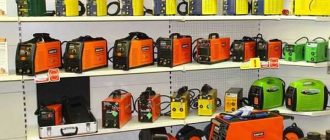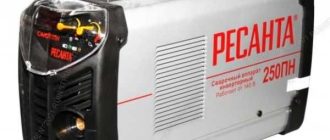Processing of lumber, cutting hinges, making technological holes and recesses, wood carving – all this can such a device as a milling machine. And it can not only professional equipment, but also relatively inexpensive manual copies. But the work of a manual wood router requires knowledge of some techniques and rules. About all this – in the article.
Contenuto dell'articolo
What is a milling machine and why it is needed
A milling machine is a device for processing wood or metal. They process flat and shaped surfaces, also forms technological notches – groove, ridge, notches for the installation of hinges, etc. According to the method of installation, there are stationary machines (there are different types to perform different operations), and there are manual milling machines. Manual electric milling machines – a universal tool that allows you to carry out any operation. To change the operation, you just need to change the attachment – a cutter and/or its location on the part.
Machines are used mainly in mass production. In them, the cutter is installed stationary, and the workpiece moves – along a certain trajectory. When working with a manual cutter, the situation is the opposite – the workpiece is fixed and the cutter moves. When processing large volumes of identical parts, it is more convenient to fix the manual milling machine on a horizontal surface, making something similar to a milling machine.
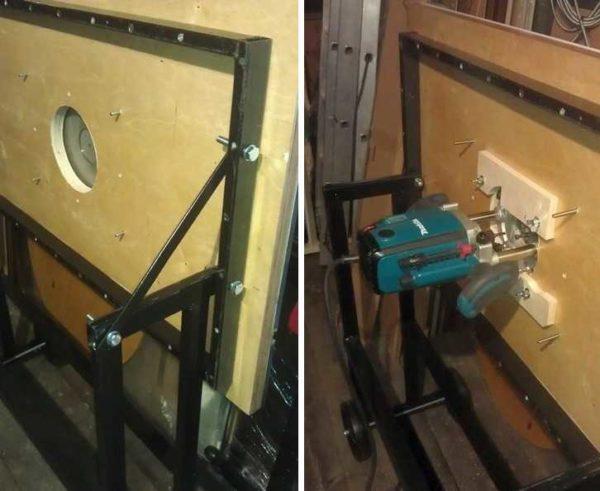
There are many different kinds of milling machines, but for the home craftsman or for semi-professional use, universal ones are more suitable. They install a variety of cutters and special attachments, which allows you to perform any operation. It just takes more time and skill to perform them than on a specialized machine.
What can be done with the help of a manual cutter:
Such operations are used in carpentry, furniture manufacturing and assembly. Even cut a lock or hinges on the door – this can also manual milling machine. And it will do it much faster and more elegantly than similar operations, but performed with hand tools.
Preparing for work and care
To understand the principles of working with a handheld milling machine, it is desirable to have at least a general idea of its structure and the purpose of the parts.
Structure and purpose of the main components
Consists of a handheld electric milling machine from the body, in which the motor is hidden. From the body is a holder, where collets are inserted. Collets are small adapters that allow you to use cutters with shanks of different diameters. The collet is inserted into the milling cutter and tightened with a clamping bolt (on some models it is fixed with a button).
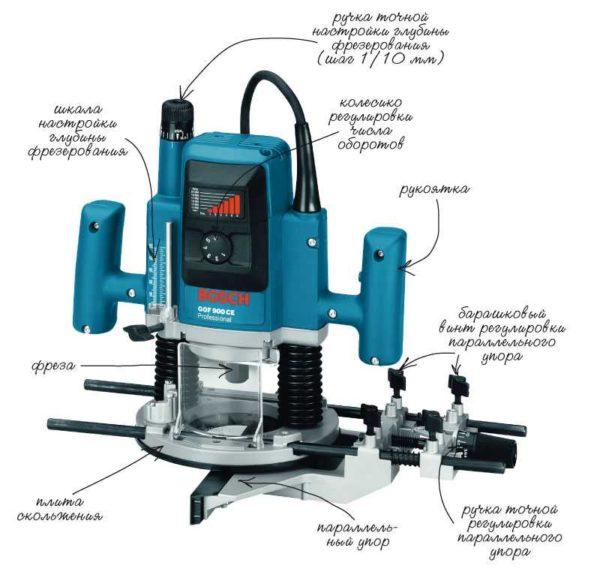
Another important part of the manual cutter is the platform, which is connected to the body with the help of two rods. The platform is usually made of metal. On the underside of the platform there is a slide plate. It is made of smooth material, which ensures smooth running of the tool as it moves over the workpiece.
The milling machine’s operating parameters are adjusted by means of:
- Knobs and jackals for adjusting the milling depth. The setting step is 1/10 mm.
- RPM adjustment. Changes the speed of rotation of the cutter. To begin with, it is worth trying to work at low or medium speeds – so it is easier at first to drive the tool.
Also necessarily on the body there is an on/off button, there may still be a lock button. Here, in brief, all the nodes. In addition, there is also quite convenient in the work of a parallel stop. It can be simple or with the possibility of adjustment – you can slightly move the cutting part to the right or left.
Care
From the factory, the equipment comes lubricated, so in principle, no additional operations are required. But it is necessary to keep the equipment clean – you should clean dust more often, change grease if necessary. Lubrication is necessary for moving parts – guides. You can use liquid aerosol greases (preferable), but you can also use ordinary grease such as “Litol”. But, when using thick greases, you will have to remove them periodically, because chips and dust adhere, and it becomes difficult to work. When using light aerosol compositions, there is practically no sticking.
In order for the soleplate to glide easily, you can lubricate it with silicone grease. This is especially useful when working with templates. Then the tool literally glides, goes smoothly and without jerks.
Rotational speed
Work with a manual router on wood, composite, plywood, etc. begins with the setting of the basic parameters. First, you need to set the rotation speed. It is selected depending on the selected cutter and the rigidity of the material and the characteristics of the cutter, so the exact recommendations should be found in the instruction manual.
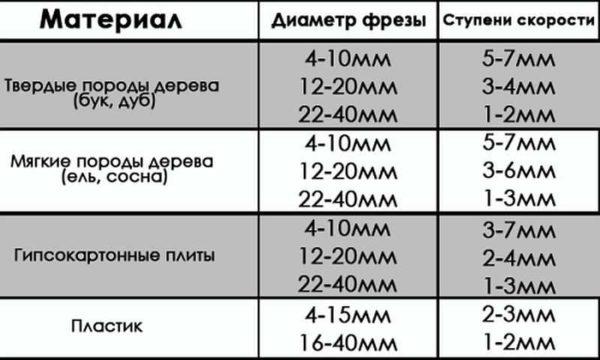
Mounting the cutter
Next, the cutter is mounted. Most brand-name milling cutters have markings that can be used as a guide. If there are none, the minimum length of the shank (cylindrical part) should be clamped at least 3/4 of the length. Insert the cutter to the required depth (if necessary, pre-installing the collet – chuck – adapter for different diameters of cutters), fasten the shaft, with a wrench tighten to the stop (but do not overtighten).
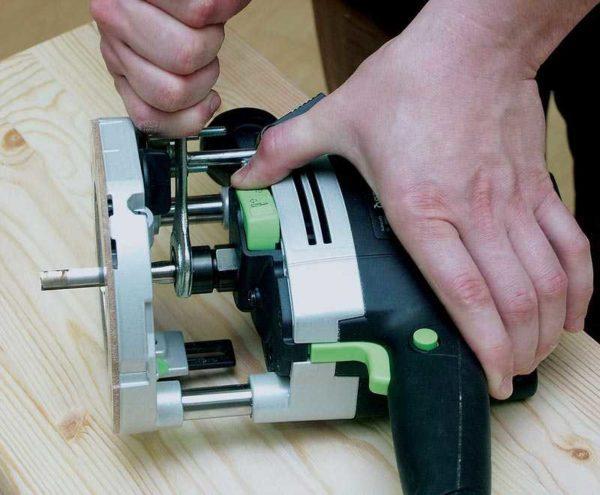
If the model is simple, you need two wrenches. They do not have a mechanism for locking the shaft, the second key will have to hold it. In middle-class machines there is a locking button. Having clamped it, you tighten the cutter with a horn wrench. In expensive models, in addition to the lock, there is a ratchet, which can be used as a guide.
Setting the milling depth
Each model of manual cutter has a certain reach – this is the maximum depth to which this unit is able to process the material. The milling depth is not always the maximum depth required, so you will need to adjust it. Even if a large milling depth is required, the milling depth can be divided into several levels to avoid overloading the milling cutter and the machine. There is a turret stop for this purpose. It is a small disk under the rod with a number of stops of different heights – legs. The number of legs is from three to seven, and more does not mean better. It is much more convenient if there is a possibility to adjust the height of each leg. This shows the class of the equipment. To fix the turret stop in the desired position there is a lock, usually in the form of a flag.
Setting the depth of milling on a manual router occurs in several stages:
- The tool is placed on a flat surface, the clamps are released, and the hand is pressed so that the cutter is pressed into the surface.
- Release the turret stop by unscrewing its lock.
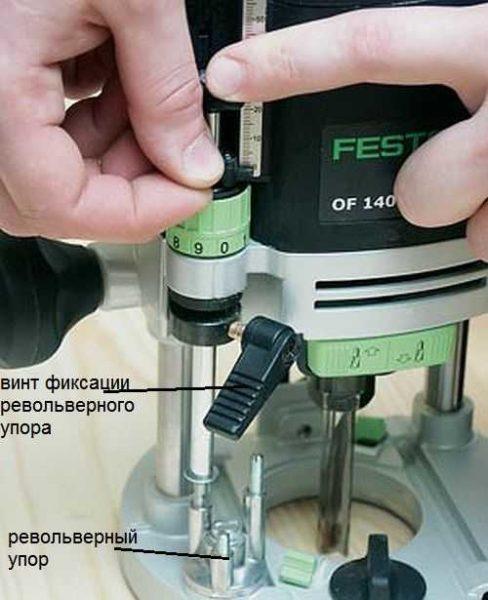
- Depending on the desired milling depth, the turret foot is selected. The disk with the feet is turned to the desired position.
- The screw is not fixed, but hold the bar with a finger, move the movable pointer so that it coincides with the zero (in the photo above).
- The rod is raised to the mark of the milling depth, and then lower the turret stop lock (on the photo below).
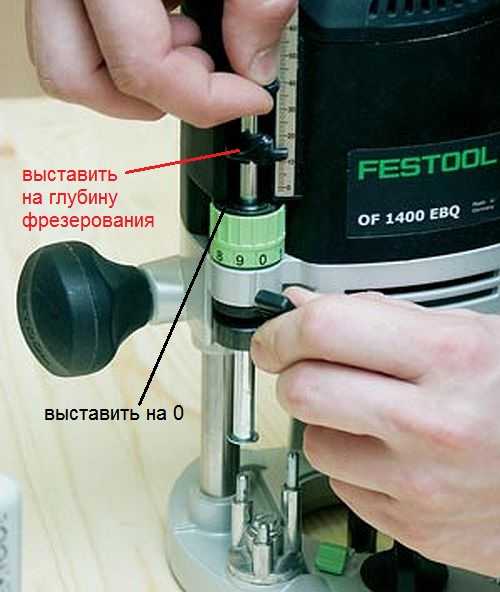
Now, when installed on the workpiece and pressing the upper part, the cutter will enter the workpiece at the set distance.
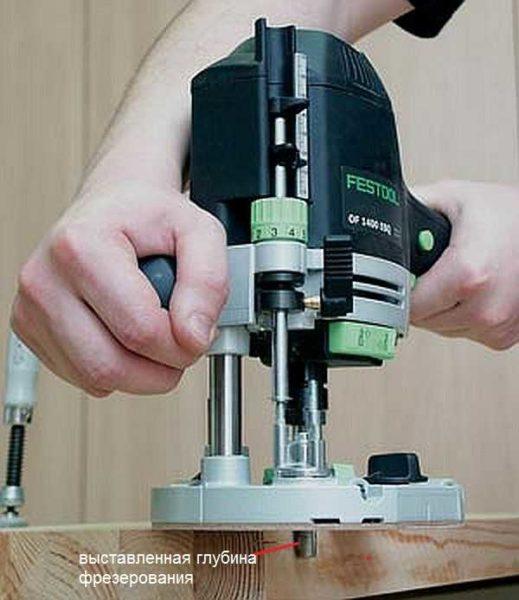
Good milling machines have a wheel for fine adjustment of the milling depth. It allows you to adjust the depth, albeit within small limits (the green wheel in the photo above) without confusing the settings (no need to repeat the whole operation).
Cutters for the hand router
Cutters are cutting tools that process and shape the surface. They consist of a cylindrical part, which is clamped with collets in the machine holder, and a cutting part. The cylindrical part can be of different diameters. Choose the one for which your machine has a collet. The shape and arrangement of the knives of the cutting part determines the look that the wood gets after processing. Some milling cutters (for edges) have a thrust roller. It sets the distance from the cutting surface to the material being processed.
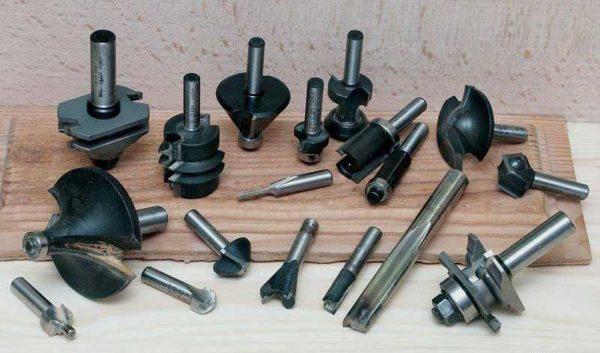
Make cutters from different metals and alloys. For processing soft wood – pine, spruce, etc. – use ordinary bits (HSS), for hard woods – oak, beech and others – from hard alloys (HM).
Each cutter has a certain resource and a maximum speed at which normal operation with minimum runout is ensured. It is not worth exceeding the recommended speed, as this may cause the cutter to break down. There is also no point in sharpening the cutter if it has become dull. It is done on special equipment (costing about 1000$), where you can set the required angle of sharpening. By hand, you will not get anything good. So it is easier (and cheaper) to replace the blunted ones, as they cost relatively little.
Popular types
There are a certain number of types of nozzles for the cutter, which are used most often.
There are simple cutters, formed from a single piece of metal, and there are set cutters. Set have a shank – a base, some set of different cutting planes, a set of washers of different thicknesses. From these parts, you can independently form the desired relief.
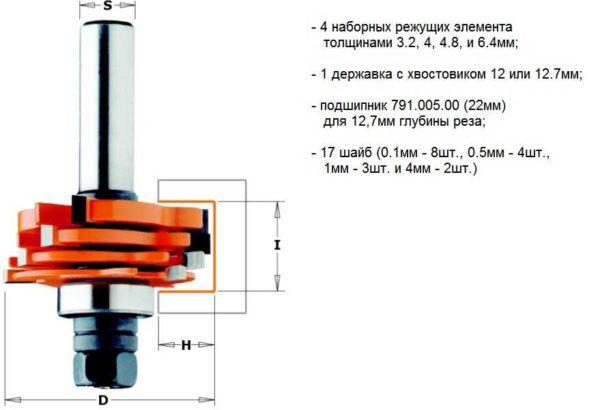
These are the most popular types of milling cutters, but there are actually a lot of them. In addition to different shank diameters, there are different diameters of cutting surfaces, their height, the location of the knives relative to each other, etc. In general, for milling with your own hands, you usually need about five of the most popular milling cutters. They are usually present all the time, and the rest are purchased for specific types of work.
Principles of work with a manual milling machine
Eletkrofresher – quite a dangerous thing – rotating at high speed sharp cutting parts can cause serious injuries, and flying from under the tool chips too. And although most models have a protective shield, reflecting the main stream of chips, safety goggles do not hurt. So working with a manual wood router requires attention and concentration.
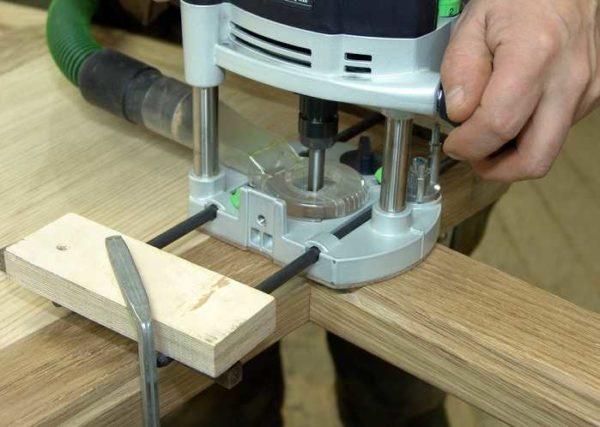
General requirements
Working with a manual wood router will be easier and more pleasant, products will turn out to be of normal quality if you fulfill some conditions:
Not so complicated requirements, but their fulfillment is the key to good work and safety. Well and the main requirement – the milling machine should be driven smoothly, without jerks, jolts. If you feel a strong runout – change the speed of rotation. Most often it should be reduced, but in general it is worth to be guided by the manufacturer’s recommendations (available on the package).
Edging – working with a template
Processing the edge of an ordinary board is easier and faster to carry out on a jointer, but if there is no jointer, a hand router can also cope, but it will take more time. There are two ways: without a template and with a template. If it is your first experience with a router, it is better to use a template. When processing the edges of boards you need straight edge cutters, and most likely you will need two – with a bearing at the beginning and at the end of the cutting part (on the photo).
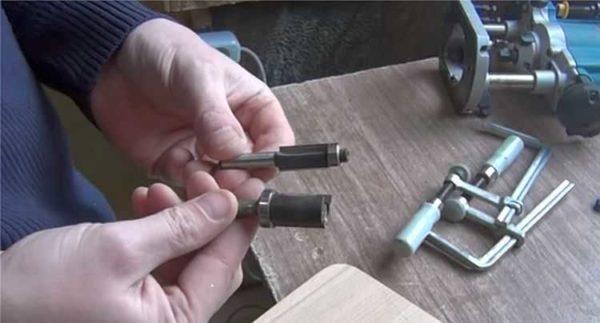
As a template, you can use an already machined board or, for example, a construction rule. The length of the template should be slightly longer than the length of the workpiece – by 5-6 radii of the cutter on each side. This will prevent the cutter from “diving” into the material at the beginning and at the end. One important point: the horizontal plane (perpendicular to the one being machined) must be flat. In any case, its curvature should not be greater than the gap between the bearing and the cutting part, otherwise the cutter will hit the template, and this is not good – it becomes non-ideal and the applied irregularities will appear on other copies.
If the width of the pattern is not more than the length of the cutting edge
Cutters have cutting edges of different lengths, but the larger the cutting edge, the more difficult it is to work – more effort is required to hold the machine. It is therefore easier to start with a medium cutter. The order of edge processing with a router (with a template) is as follows:
- You set the template in such a way that it sets the required flat surface – by indenting the required distance from the edge.
- The workpiece with a template is securely fastened to a table or any other horizontal surface.
- Install a cutter with a roller in the middle part. It is set so that the roller rolls on the template, and the cutting part – on the workpiece. To do this, set the cutter on the fixed workpiece with a template, put the milling machine unplugged, adjust the position of the nozzle, clamp it.
- Set the cutter in the working position – lower the body, clamp it.
- Turn on the manual milling machine, guide it along the template. The speed of movement is determined by the depth of processing. You will feel everything yourself.
- And how to lead the milling machine? Pull or push? It depends on which side you are standing on. If the workpiece is on the left, you push, if it is on the right, you pull. You can also orient yourself by the flight of chips – they should fly forward.
That’s all there is to it. After you have finished the pass, evaluate the result, remove the clamps.
This, by the way, is another way to remove a quarter along the edge of the workpiece or in some part of it. To remove the quarter, you set the cutting part so that the processing was a given depth.
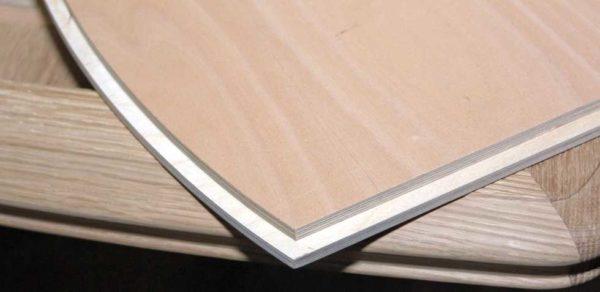
Changing the cutter to a shaped (grooved) and displacing the template or using the included stop, you can put a longitudinal pattern on the workpiece (pictured below).
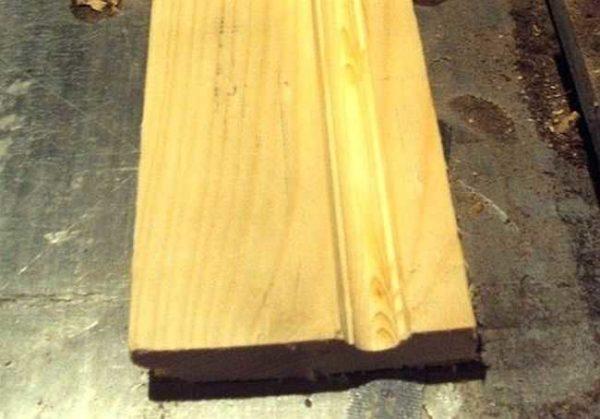
In general, this milling technique is quite convenient. For the first steps in woodworking it is the best way to “get your hand on”, further on you will be able to smooth edges even without guides.
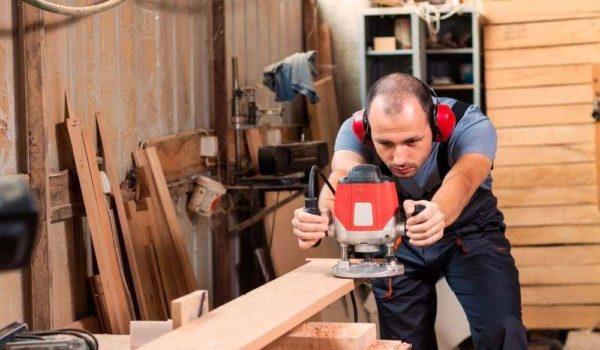
The width is greater than the length of the cutting part
What if the thickness of the workpiece is not more than the length of the cutter? In this case the work with the hand-held wood router continues:
Now the edge is completely machined on one side. If necessary – repeat with the second side. And in general, to master the work with a hand-held wood router, you will need several “rough” blanks. Choose from those that are not sorry to throw away – at first there will be a lot of joints, then gradually learn.
Obtaining shaped and curved edges
If you need a rounded or any other form of edge rather than a flat one, you should look at the condition of the existing edge. If the workpiece is more or less flat, take the necessary edge cutter, set it and process the surface as described above. If the surface is too curved, it is first brought to a normal state and then milled.
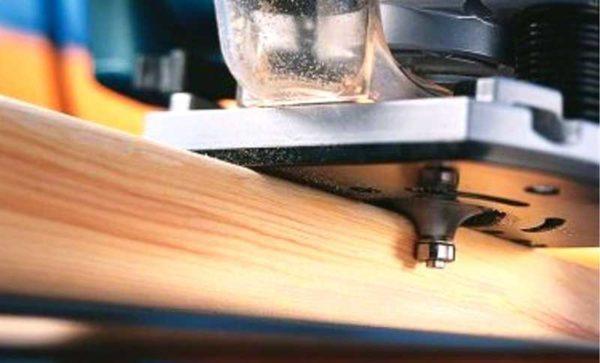
This is necessary because the bearing roller is rolled over the surface, and if there are errors, they will be copied. Therefore, act consistently – first smooth, then give curvature.
If you need a curved surface at all – cut out a template. Drawing is applied to plywood thickness of 8-12 mm, first it can be sawed out with an electric jigsaw, because the edge to bring to a perfect state milling machine.
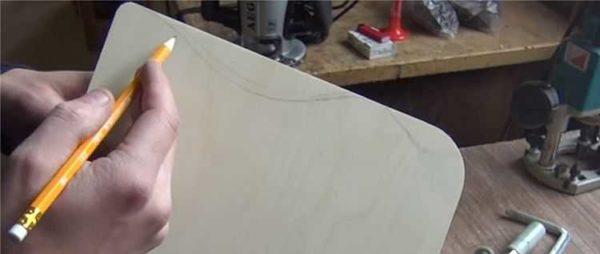
In this case, too, you will have to work with a router, but without a template. When the surface will be ideal, the template is fixed to the workpiece and further described above work with a manual wood router. Only one moment: if you remove in some places will need a large amount of material, it is better to do it with a jigsaw, for example. Otherwise, the cutter will quickly become dull.
Video tutorials on working with a hand-held router
When installing doors it is necessary to cut the hinges, how to do it with a router – in the following video (there is also how to make a groove, for example, under the installation of a dobro).
How to make a homemade milling machine from laminate samples (you can plywood) and how to make a spike joint for drawers (table, for example) – in the following video
Working with a manual wood router is not badly shown in the following video, but it is in English. Even if you do not know English, do not spare time, watch it. Many operations will become clearer.

